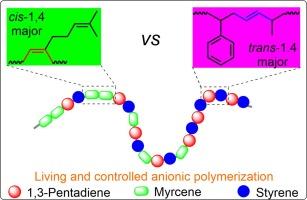The influence of myrcene on anionic copolymerization of 1,3-pentadiene and styrene
IF 5.8
2区 化学
Q1 POLYMER SCIENCE
引用次数: 0
Abstract
C5-dienes including 1,3-pentadiene (PD) and isoprene (IP) as by-products of naphtha cracking are important industrial raw materials for the production of thermoplastic elastomers, synthetic rubber and resins. The research on living anionic polymerization (LAP) of myrcene (MY) is also of great significance for the development of new bio-based materials and products. Focusing on the optimal utilization of C5 resources and the high-value utilization of biomass resources and the realization of green chemical production, this article reports the synthesizing of a novel terpolymer by LAP of PD, styrene (ST) and the biomass monomer MY. The discovery of the alternating sequence structure of ST and PD inspires us to further explore the development of copolymers containing this unique sequence structure. The special long branched side chain of MY and its low glass transition temperature are also conducive to the synthesis of new integrated rubbers. The 1H NMR tracking analysis indicates that the polymerization pattern changes from alternating sequence to gradient block sequence with the increase of MY content. Combined with FTIR analysis, the PD monomeric units are mainly trans-1,4 structure and MY monomeric units are predominant cis-1,4 structure. Considering the extremely high polymerization activity of MY compared to ST and PD, the copolymerization rate is significantly dependent on the concentration of the PD monomer. Despite this, due to the interactions between ST and PD ([ST¦PD] intermediate), ST still tends to form alternating segments with PD. The ternary copolymerization can be viewed as a “binary gradient copolymerization” of [ST¦PD] and MY (rMY > r[ST¦PD]).

月桂烯对 1,3-戊二烯和苯乙烯阴离子共聚的影响
石脑油裂解的副产品 C5-二烯(包括 1,3-戊二烯 (PD) 和异戊二烯 (IP))是生产热塑性弹性体、合成橡胶和树脂的重要工业原料。对月桂烯(MY)活阴离子聚合(LAP)的研究对于开发新的生物基材料和产品也具有重要意义。本文以 C5 资源的优化利用和生物质资源的高值化利用以及实现绿色化工生产为重点,报道了活阴离子聚合(LAP)法合成 PD、苯乙烯(ST)和生物质单体 MY 的新型三元共聚物。ST 和 PD 的交替序列结构的发现启发我们进一步探索含有这种独特序列结构的共聚物的开发。MY 特殊的长支链侧链及其较低的玻璃化转变温度也有利于合成新型集成橡胶。1H NMR 跟踪分析表明,随着 MY 含量的增加,聚合模式从交替序列变为梯度嵌段序列。结合傅立叶变换红外光谱分析,PD 单体单元主要是反式-1,4 结构,而 MY 单体单元主要是顺式-1,4 结构。考虑到与 ST 和 PD 相比,MY 的聚合活性极高,因此共聚率在很大程度上取决于 PD 单体的浓度。尽管如此,由于 ST 和 PD 之间的相互作用([ST¦PD] 中间体),ST 仍倾向于与 PD 形成交替段。三元共聚可以看作是[ST¦PD]和 MY 的 "二元梯度共聚"(rMY > r[ST¦PD])。
本文章由计算机程序翻译,如有差异,请以英文原文为准。
求助全文
约1分钟内获得全文
求助全文
来源期刊

European Polymer Journal
化学-高分子科学
CiteScore
9.90
自引率
10.00%
发文量
691
审稿时长
23 days
期刊介绍:
European Polymer Journal is dedicated to publishing work on fundamental and applied polymer chemistry and macromolecular materials. The journal covers all aspects of polymer synthesis, including polymerization mechanisms and chemical functional transformations, with a focus on novel polymers and the relationships between molecular structure and polymer properties. In addition, we welcome submissions on bio-based or renewable polymers, stimuli-responsive systems and polymer bio-hybrids. European Polymer Journal also publishes research on the biomedical application of polymers, including drug delivery and regenerative medicine. The main scope is covered but not limited to the following core research areas:
Polymer synthesis and functionalization
• Novel synthetic routes for polymerization, functional modification, controlled/living polymerization and precision polymers.
Stimuli-responsive polymers
• Including shape memory and self-healing polymers.
Supramolecular polymers and self-assembly
• Molecular recognition and higher order polymer structures.
Renewable and sustainable polymers
• Bio-based, biodegradable and anti-microbial polymers and polymeric bio-nanocomposites.
Polymers at interfaces and surfaces
• Chemistry and engineering of surfaces with biological relevance, including patterning, antifouling polymers and polymers for membrane applications.
Biomedical applications and nanomedicine
• Polymers for regenerative medicine, drug delivery molecular release and gene therapy
The scope of European Polymer Journal no longer includes Polymer Physics.
 求助内容:
求助内容: 应助结果提醒方式:
应助结果提醒方式:


